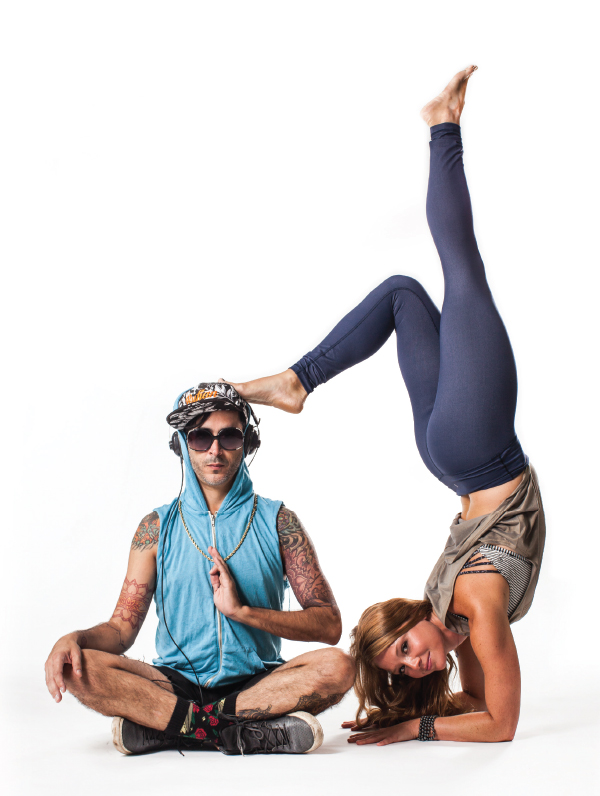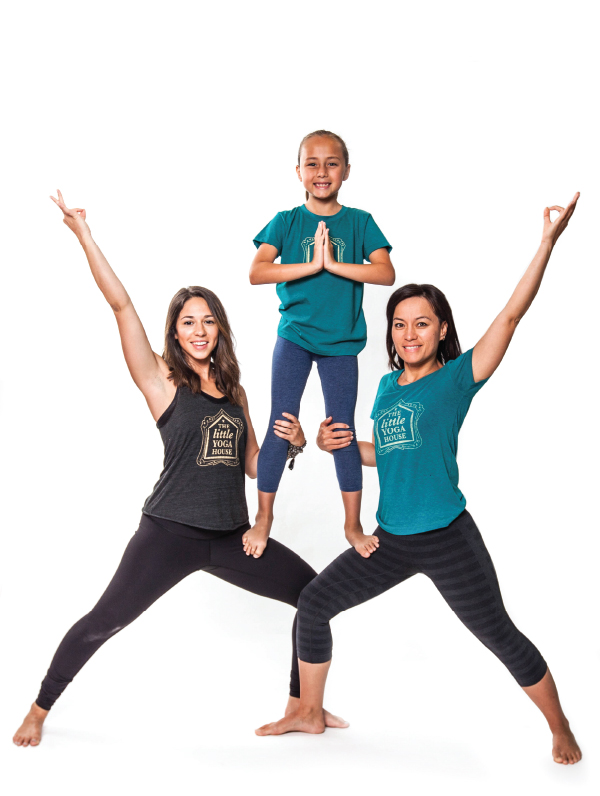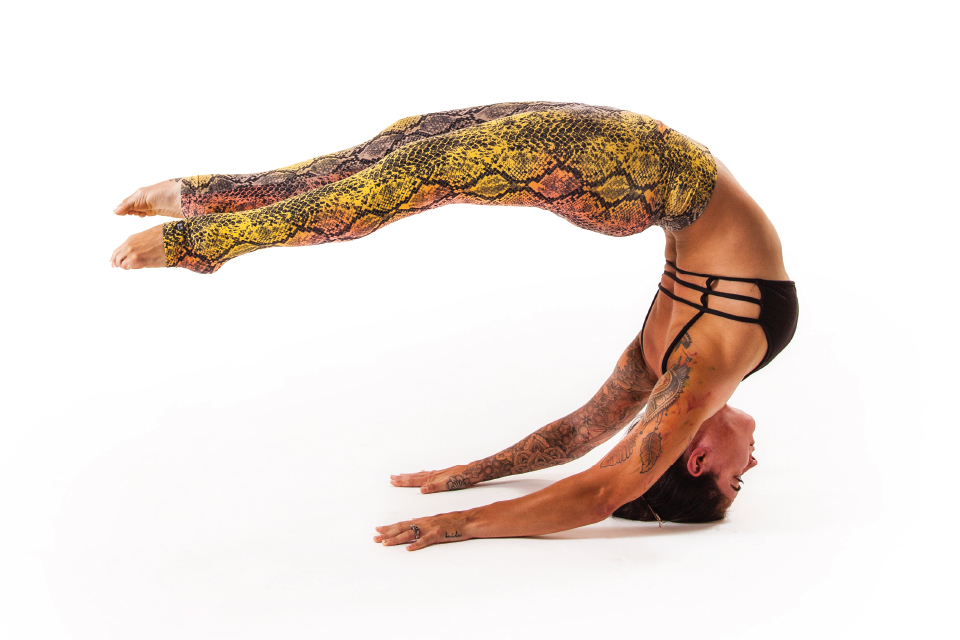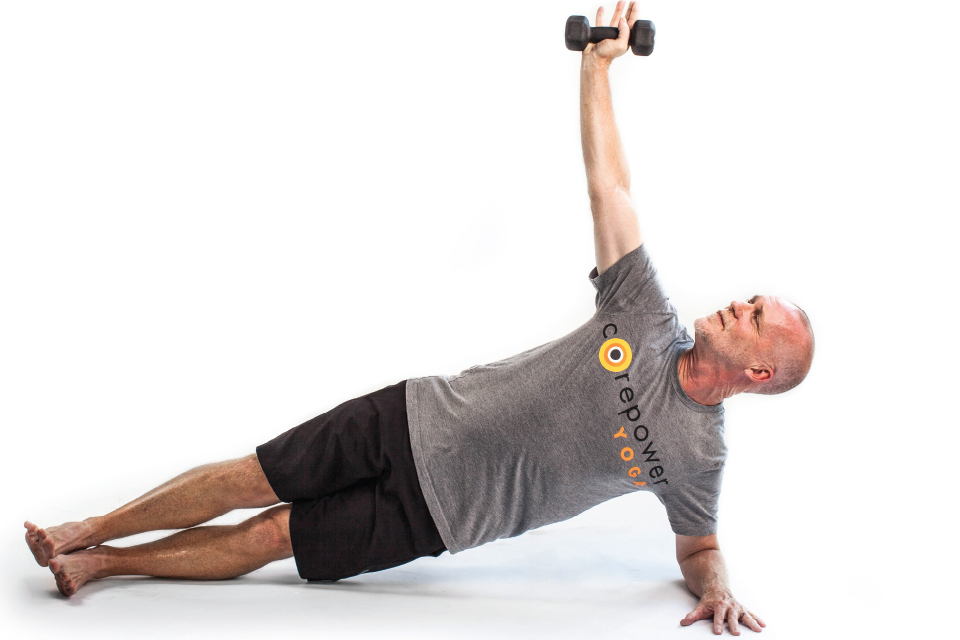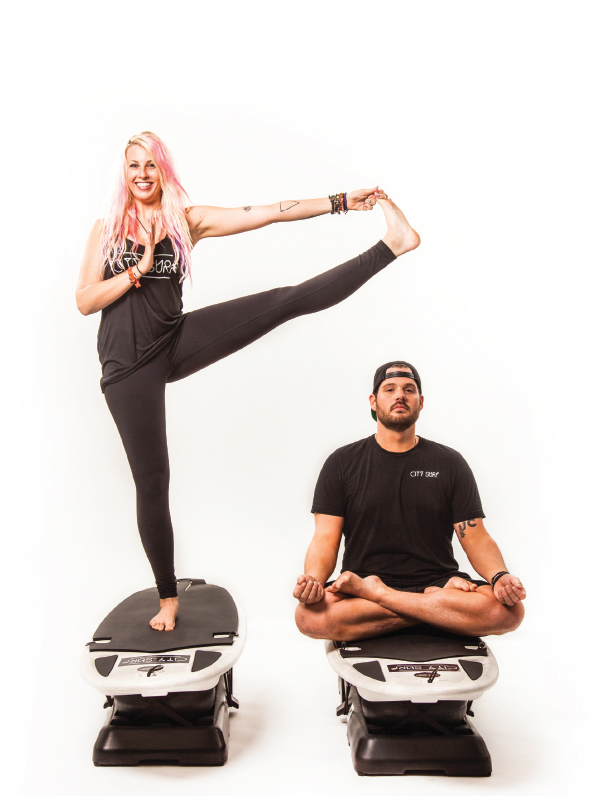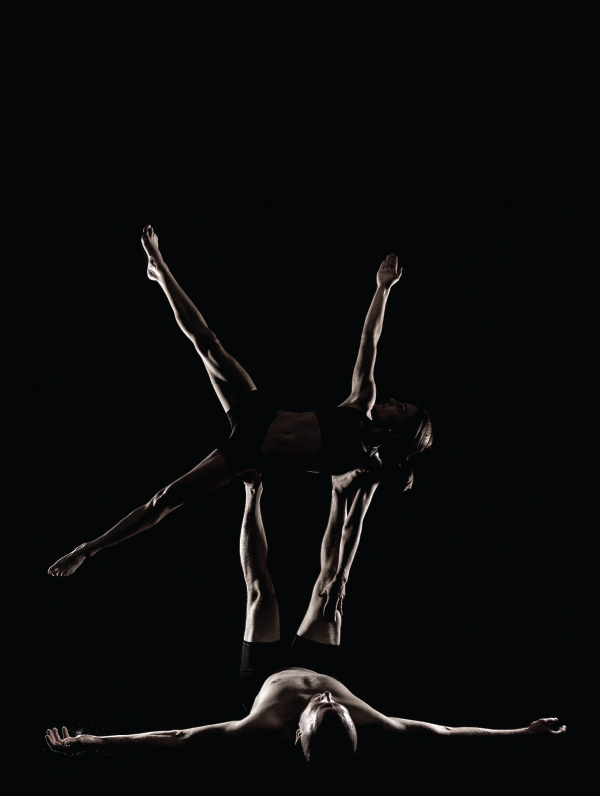The New Age of Yoga

The Yoga Remix
For a more fast-paced, edgier type of yoga, look no further than the House Yoga class at Pure Austin. This gym offers various comprehensive yoga programs taught by highly qualified teachers with years of training and experience. All classes are free to members of Pure Austin and are great as stand-alone workouts or as your post-workout stretch. Or if you want to add a little fun to your exercise regimen, you can join Pure Austin’s one-of-a-kind House Yoga class, taught by Jessica O’Brien, with music once a month by DJ Manny.
House Yoga got its name from the electronic, remixed songs—also known as “house music”—that is played during the class. A staple in many nightclubs, the music is characterized by heavy bass, synthesizers and repetitive rhythms creatively crafted by a disc jockey. Whereas most yoga classes tend to play music that sets a calming tone, house music provides a high-energy vibe, serving as a perfect fit for this upbeat power Vinyasa yoga class. “That’s what makes this class different,” O’Brien says. “It’s not your normal flutes, whistles and cymbals.”
Usually, O’Brien has to assemble a fresh playlist of music for each of her classes. But on the fourth Wednesday of each month, students of House Yoga flow along to the music of DJ Manny, who plays the right jams to keep the class going through O’Brien’s quick and exalting workout. The faster tempo makes this class challenging, but the constant moving and grooving provide a pleasant distraction from the straining and sweating.
O’Brien, who has been teaching House Yoga at Pure Austin for two years, has gained a group of loyal regulars, many of whom come each week with a general idea of what the class will be like. It often includes various forms of crow pose, handstands, hops, jumpbacks and distinctive warrior flows.
“I love all my regulars who come in,” O’Brien says. “But it gets even more exciting when I see curious students who walk in wondering what my House Yoga class is all about.”
In addition to structuring a class that will be inviting to newcomers, she says she strives to give returning students more of what they came for. But once she sees students moving ahead to the next predicted pose, she switches it up.
“My class is mostly made up of advanced Vinyasa,” O’Brien says. “But I like throwing in surprises every now and then, because I know they’re ready for it.”
At Pure Austin House Yoga, it’s all about the musical element, and though it can be perceived as challenging, it is a great way to change up your yoga Zen and try something radical.
“I come to this class a lot. I enjoy the intensity of it. It’s not your natural flow. It’s a hard workout,” class regular Katelyn Scalabrini says. “I have a friend that usually joins me, and we joke that it’s a CrossFit-meets-yoga class. I love it!”
Pure Austin’s motto is “To Be the First, the Best and the Only,” and their House Yoga class epitomizes that. O’Brien and DJ Manny say they plan to keep bumping beats while building individual yet interlacing flows that offer a unique yoga experience. – Devyn Bernal
UP NEXT: The Little Yoga House
Little Yogis
There is a purple tire that swings from a tree in front of a little house in Central Austin. Kids ranging from tots to toddlers to preteens gather in the yard before going inside. This is The Little Yoga House.
Offering a variety of programs including classes, camps, workshops, and parties, The Little Yoga House (TLYH) teaches yoga, music, dance, and art to kids of various ages, from infants to teens. Conceived by Abby Nagler in 2010 and opened in 2012 with her co-owner An Dang, TLYH champions the benefits of yoga for kids.
At TLYH’s summer camp, which takes place from 9 a.m. to 1 p.m. on weekdays, Dang starts a Wednesday camp with a bit of an interruption. A little girl is crying because she misses her parents, who have just dropped her off. Before starting the class, Dang acknowledges to the class of about 10 other three- to four-year-olds that their friend is upset. She asks the group, “What can we do to make her feel better?” A teaching moment has presented itself. Dang reminds her students that breathing deeply often helps all of us feel better. Shortly thereafter, another little girl joins her upset friend, softly pats her on the back, and both sit together on the same mat.
“We see how breath and movement actually helps them release the anxieties and fears they have about being away from their parents.” says Nagler. “Where an adult yoga class can be a very individual practice, a kids’ class is a very communal-based practice.”
Part of TLYH’s goal is to help kids develop important skills in a fun, noncompetitive environment. “We’re not trying to build big muscles, or help them lift their foot over their head,” says Nagler. “But we’re teaching them how to be strong in their lives, how to be mindful, and to be aware of their place in the community.”
As Dang continues this part of camp, the emphasis on respecting the other students is constant. Because young kids have varying energy levels and attitudes and personalities, Nagler says that “management in the biggest challenge.”
But TLYH embraces its clientele of youngsters by incorporating kid-approved tools like stuffed animals and building blocks to enhance each activity. Think: balancing a beanie baby on your head, using your feet to build a house, or practicing animal poses such as the dragon, caterpillar, cat, or flamingo.
At the end of Dang’s activities, Nagler joins the group to finish with breathing exercises. Each child lays flat on on a mat, belly up. Nagler places a small, colored stone on each child’s forehead and gives the child a mini foot rub. As she makes her way around the circle of mats, she says the colors of the rainbow, followed by affirmations. For example: Red, I am strong; green, I am kind and generous; indigo, I am wise and creative; etc.
“Yoga isn’t just downward dog or warrior two,” says Nagler. “We’re teaching them how to interact with each other, how to be respectful to themselves, how to tune into what’s happening in their bodies.” Nagler adds, “That’s a pretty heavy concept for a 3-year-old, but you would be amazed.”
Nagler witnesses improvements that take place in a single day and some that span a semester’s worth of classes. Parents are happy because they see improvements in everything from attitude to test scores. TLYH’s approach is so successful that they have their own curriculum that is being taught in several Austin schools and preschools, and they are opening a second location in the fall.
While Nagler says that part of kids yoga is simply “getting down to their level,” TLYH is actually taking it up a notch. Their new location will focus on providing therapeutic-based yoga for children with sensory process disorders. Additionally, they’ll offer aerial yoga for kids of ages 5 and older, which involves practicing yoga from within hammocks suspended from the ceiling. —Emily C. Laskowski
UP NEXT: @Casa_Colibri
#InstaYoga
Looking to add some spunk and color to your newsfeed? Look no further than Stephanie Gongora’s active account, @Casa_Colibri. A gymnast turned yogi, Gongora began sharing her stretches on Instagram a few years ago. Since then, her account has reached over 61,000 followers, and she’s expanded to other social media platforms while making countless friends and connections along the way. So how did this begin?
“Casa Colibri means Hummingbird House. I’ve always admired the tiny little birds, who, despite their size and delicate appearance, can accomplish some amazing feats. When I grew up, my grandmother in Mexico would often call me her little ‘chupaflor,’” said Gongora. “My Italian grandmother, on my mother’s side, once referred to me as her little hummingbird. It wasn’t until years later that I learned chupaflor was another word for colibri, also meaning hummingbird. The Casa Colibri name was born from my love of flight. I love being upside down, and I’ve always loved pole and hoop, so by the time yoga came into the picture as my main physical passion, the name had stuck and still seemed appropriate.”
Gongora now has Casa Colibri (@Casa_Colibri) accounts via Facebook, Instagram, Twitter, Snapchat, and Periscope, all under the same tag. She captures her photos either through self-timer or her husband, Ben House (@Apache_Athlete) stands in as her photographer if he has the time.
Gongora’s method is that if you post a beautiful king dancer pose that gets all the likes, don’t be afraid do a follow-up video post that is two minutes of you wiggling and wobbling to get into the deepest expression of the pose for three seconds so you could snap a picture.
“Be genuine,” Gongora says. “That is the key, and I mean be genuine in all senses of the word.”
People like to hear that every handstand isn’t perfect, that even the experts fall constantly, that it’s not uncommon to neglect your weak side (hence one of Gongora’s first signature tags – #weaksidewednesday). She’s learned that using the @Casa_Colibri account to demonstrate transparency and share her struggles is one of the reasons followers can appreciate her success.
Gongora also stays true to herself by posting other tidbits of her life, such as pole, lyra, her dogs, and living in Austin.
“I’ve found that showing little glimpses of my life outside of yoga actually makes people happy and relate to me more,” said Gongora. “I’m genuine in what I post about, regardless of whether or not certain people or groups will disagree with or unfollow me. I am not a vegan or vegetarian, and I don’t pretend to be. Sometimes, I have a beer or two. Sometimes I miss a practice because I want to watch Netflix all night with my husband. And that’s OK.”
There are myriad small businesses on social media, especially in the world of yoga. Gongora believes in only representing products and brands that you believe in and would personally buy items from, whether the items were gifted to you or you actually purchased them.
“Accepting any free handouts in exchange for posts will swiftly turn your account into an infomercial,” she advised. “Purchase a few things that you love from companies you support, and then post some high quality pictures wearing the gear on your account. If you tag them, most companies will return the favor with a repost down the line. But always make sure it’s something you want to be associated with.” Gongora believes that you should be yourself, and share what you like. Not everyone will respond to it, but they have to respect you for it.
So what’s the future like for Casa-Colibri? Gongora plans on continuing her social media-centered sharing, as well as a 300 hour yoga training. She plans on developing a branded website, as well as engaging new followers through her latest hashtag, #AustinYogaMeetUp. In the meantime, she’ll continue using social media to develop her own yoga practice, to encourage others to try yoga or other forms of physical fitness, and to help raise awareness and funds for charity organizations she supports.
Everyone has a different way of sharing their passion, and Gongora’s came in the form of unintentional leadership on social media. While she can’t ever see herself teaching 10 classes a week at a set location and time, she keeps finding and building upon opportunities to cultivate community, in and outside of Austin. After all, that’s what this union is all about.
“Yoga is the impossibly intricate yet surprisingly simple web that is woven with every thought, movement, emotion, intention, and deep inner summoning,” said Gongora. “And we are all weavers.”
UP NEXT: CorePower Yoga & Wanderlust
Worth the Weight
Sweat drips onto the floor. Heavy-breathing bodies glisten with perspiration. Towels turn a damper, darker color. The scene is a typical aftermath of a yoga with weights class.
Yoga, with weights? Yes, it exists, and by the way, it’s also heated. It makes you sweat, makes you sore (watch out for that second day), and makes you realize that, if it wasn’t already, yoga just might be for you.
For some, yoga represents the answer to all of life’s questions. For others, it’s an hour that could have been spent running or rowing or swimming or spinning or any other sort of workout. But yoga with weights offers a unique challenge for everyone.
“The class moves faster than a normal yoga class,” says Joel Homme, who teaches the Yoga Sculpt class at CorePower Yoga. “By the time we pick up weights, people are pretty warmed up.”
Homme, who also manages CorePower’s studio downtown at the Monarch, witnesses the benefits his students get from this type of enhanced yoga. It has helped athletes ward off injuries while building strength without the joint pain and helped yogis master advanced skills by intensifying their training. No matter who you are or what your level is, it diversifies your workout regime.
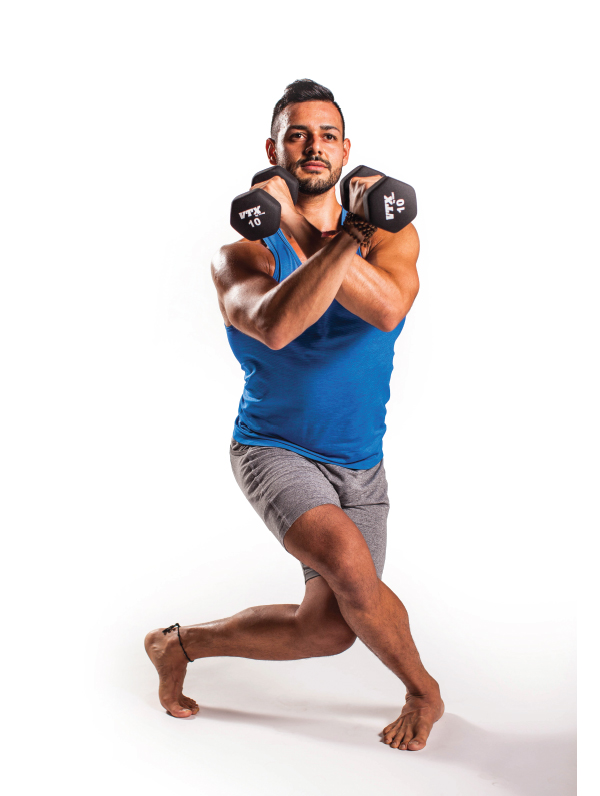
In Austin, new workouts and fitness classes are welcomed by the community. “It’s a bunch of chronic recreators,” says Homme of Austin and why it is such a great place for classes like Yoga Sculpt. There are similar classes offered at yoga studios across Austin, including the YoStrong class at Wanderlust.
Gustavo Padron, who teaches at Wanderlust, embraces the sweat factor of YoStrong. A self-described “sweat junkie,” Padron was one of those people who didn’t get yoga. “I hated it at first, the stillness and the quiet,” says Padron.
That was, until a shoulder injury changed his perspective. “I started to heal, and I started to look more into it, and I was hooked. I was telling myself, this is the way to heal your body in a safe way.” While both Yoga Sculpt and YoStrong follow similar patterns of movement and pace within the class, each has its own distinct vibe and personality.
CorePower’s class at 5:30 p.m. on Mondays is chocolate-box full of positive energy. The room is light and open thanks to a wall of floor-to-ceiling windows peering onto Fifth Street. Before class, there is lots of visiting while stretching, getting excited about what’s to come. Once the class starts, an anthology of current pop and R&B hits makes each movement a little bit more fun.
Wanderlust’s class at noon on Thursdays wields relaxation and peacefulness. Groups of candles line the edge of the room, which is dimmed and contained by a wooden ceiling. The softness of sound inside the room encourages some to stretch, lie on their backs, or sit, eyes closed. Once the class starts, the deep, almost-hymnal music grows in intensity with the class.
Yoga studios across Austin offer distinct options like these two classes that suit many preferences and attitudes. The constant factor in all of these classes is the option to do as much or as little as you want. “Holding warrior two without weights is pretty challenging,” admits Padron. “Adding that strength component just intensifies the class even more.”
It’s the strength component that attracts people in the first place, adds Padron, “Because it’s not so yoga.” However, the well-known calming benefits of yoga weave in and out of each class. “I love that little spot where people are not checked out, but they’re just right there,” says Homme of the satisfaction he sees in his students. “There’s a glint of bliss.”
Thanks to the heat that a class full of active bodies provides, there’s also so much more than a glint of sweat. —Emily C. Laskowski
UP NEXT: City Surf Fitness
Surf's Yoga
City Surf Fitness is one of Austin’s newest boutique fitness studios, offering six types of group fitness classes that use RipSurfer X boards. This gym has designed a variety of unique moves that challenge class participants in balance, cardiovascular endurance and strength. Every City Surf class ends in Savasana (also known as corpse pose), a restorative yoga pose that fosters complete relaxation by having the students lie down on their backs on their boards during a cool-down period. However, one class in particular embraces yoga and involves more poses and flows: Buddha Board.
Buddha Board is City Surf’s version of a Vinyasa flow yoga class, performed on the RipSurfer X boards. What makes Buddha Board unique, other than being done on an elevated surfboard, is that the board moves in the direction of weight displacement. If there is too much weight on either side of the board, it will lean that way just as a surfboard would in the water. This challenges and improves any yogi’s practice by requiring one to remain centered at all times. If not, there is a good chance of falling off, but as countless students and instructors have done, you pick yourself up and try again.
“The board will toss you right out if you’re not balanced right,” says Andrew Heller, the manager of City Surf in Austin. “But once you let it change your practice and return to a stable surface yoga class, you’ll kill it!”
Even the studio brings a calm, sea-like vibe to class, complete with a mural of ocean waves adorning the walls. Zuzu, one of the most exuberant and popular instructors (and the artist behind the mural), teaches the Buddha Board class. The experience of guiding this yoga practice surrounded by her artwork brings a Zen that is rarely found in other studios. Combine that with dimmed lights and the latest chill Spotify playlist Zuzu discovered that day, and Buddha Board is nearly as peaceful as being on an isolated beach.
If you have never spent a day on a surfboard, don’t be intimidated. City Surf offers modifications for beginners. Buddha Board teaches to all levels of yogis, whether they are experienced and wanting to take their “namaste to the next level” or novices wanting to try something new. At any point in a class, students are welcome to hop off the board and continue on a yoga mat if that is more comfortable.
Although Buddha Board is only offered Tuesday through Friday, City Surf recommends practicing balance all week long.
“We are fairly unique when it comes to this sort of yoga, but Stand Up Paddleboard yoga is similar,” Heller says. “You can take Buddha Board during the week, then take it to the lake on the SUP for the weekend.”
Surfing is huge in Austin, despite the lack of “big kahuna” waves, and City Surf’s staff is grateful for the chance to get creative while involving the yoga community. They encourage yogis to embrace City Surf as an off-water, on-board training experience, one you can’t find on a mat. – Devyn Bernal
UP NEXT: Yogabatics
Acroyoga
photography by Bradley Thomas
Yoga is calming and strengthening. It’s time spent in your own mind. Sharing that experience with others, though, can expand the possibilities of what yoga can be.
Acroyoga is a fun, experimental and social exercise that combines yoga, acrobatics, dance, and Thai massage to create a completely unique workout.
Instead of forming poses on the floor, people work together to hold dynamic positions in the air. One person (the base) lies on the ground with back pressed against the floor. The base then raises arms and legs in the air to support a second person (the flyer) above.
Grant Shipman, founder of Austin’s acroyoga studio Yogabatics, said many people are hesitant to try acroyoga for fear of being too weak to support someone or too heavy to be held up. The secret lies in “bone stacking”, or creating 90-degree angles with your body by stacking your ankles above your hips and your hands above your shoulders. This transfers weight from your muscles to your bones, allowing you to lift someone even double your own weight.
While this can be tricky to master, Shipman said it’s all about balance and trust. “Once two people know what to do, then it becomes more of a dance,” he said. “Both people can lead, and the flyer has a lot of control of what’s going on. They’re not just an object in the air.”
Alignment with your partner is crucial from the start, as staying in sync makes it less likely to fall over. This balance becomes second nature, Shipman said, which allows partners to move from pose to pose, building strength and flexibility along the way.
“You’re getting way more flexible because you’re not trying to be flexible. You’re just trying to hold someone up or be held up,” he said. “Your body’s focusing on something else, so your muscles just do what they need to do, which is to be flexible and become stronger.”
Unlike traditional yoga, acroyoga gives more freedom to experiment with your partner and create new poses, Shipman said. “Perfection is let go of, because you’re working with two people’s limitations and strengths, as opposed to just one.”
Relying on your partner’s abilities and letting go of your own inhibitions can be challenging but liberating, he said. This often builds a strong connection between acroyoga partners.
At Yogabatics, beginner and intermediate classes are offered in five-week sessions. Drop-in classes are also available—no experience or partner required. After you get in the air you won’t want to come down, Shipman said.
Hardcore yogis or purists may question branding this exercise as yoga, but acroyogis aren’t concerned with titles. Acroyoga is fun, makes you laugh and learn from your mistakes, and challenges you to trust and connect with others through movement. Neither traditional yoga nor acroyoga practice is better than the other, and it can be mutually beneficial to practice both.
Like traditional yoga, anyone and everyone is welcome to join acroyoga, no matter your size, flexibly or experience level. There’s no excuse not to try it! —Lauren Pape
